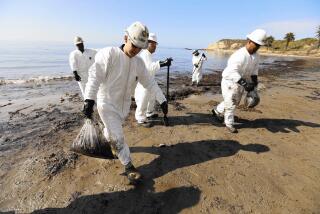In West Texas oil boomtowns, ‘the end is near’
Fear blew in fierce over a patch of West Texas late last year, falling fast and without warning through gray skies to alight on the shoulders of men and women who depend on oil for their livelihoods.
Oil that was once $100 a barrel started selling for $75, then $60. Well drillers started pulling out. The rumbling truck traffic slowed.
Andrews National Bank director Russell Shannon has been through this before, back when he helped found the bank in 1983 and an oil glut sent prices spiraling down three years later. He experienced it again in the late 1990s, watching oil prices drop and a minor recession take hold. And when the Great Recession struck in 2008, months became years of belt-tightening.
With Texas crude down to $50 a barrel, Shannon is again watching those drunk on quick profits and high returns wake up bleary-eyed to a grim few months.
“There may be a cleansing,” Shannon said. “When you hear on the radio, ‘Got $40,000, own a piece of an oil well,’ you know the end is near.”
Across the U.S., skyrocketing oil production rooted in the fracking boom is just beginning to feel the effects of collapsing prices. One indicator, the number of rigs in operation, is down 23% from February 2014. Oil exploration is down more than 25%.
Houston-based Halliburton Co., an oil field equipment and services company, reported that it laid off 1,000 workers in the fourth quarter of 2014. Industry giant Baker Hughes Inc. said it would eliminate 7,000 jobs and Schlumberger NV announced it would cut 9,000 jobs.
Texas oil production is still up 700,000 barrels a day from what it was a year ago — the state produced 2.3 million barrels a day in December — but the slump in prices already is taking a toll. The number of well completions so far in 2015 is 3,607 fewer than the number during the same period in 2014, according to the Railroad Commission of Texas, which regulates oil production in the state.
“Midland used to be the home of the tumbleweed and jack rabbit,” said Stephen Trammell, research director at Colorado-based research firm IHS Inc. “We’re not going back to tumbleweeds in Midland just yet.”
Texas has diversified its economy over the years, and hospitality, construction, trade and leisure aren’t directly dependent on oil prices. A state with a growing labor force, lots of land and a steady influx of immigrant workers, Texas has done relatively well during the post-recession economic expansion, and it wasn’t all because of oil. Oil production taxes amount to about $3 billion, or just 3% of the state’s total take.
But towns like Andrews, the fastest-growing small city in Texas over the last two years, are the canaries in what many fear may be the next bust. With more than 80% of the town’s economy depending on oil, city officials are bracing for possible cuts in government services. School officials say they have no way of knowing how many students will be enrolled next year.
“It’s bad here,” said Rachel Galindo, co-owner of G and G Roustabout in nearby Midland. Galindo founded the company, which services oil fields with workers and trucks, with her husband during the apex of the boom four years ago.
Now she has cut her oil field workers’ wages by 10%. During the boom, they worked 60 to 70 hours a week. Now it’s closer to 40.
“In two weeks, we’ll have to give them notice; we’re doing layoffs,” Galindo said. “If it stays low, I don’t know how we’ll make it.”
::
The story of the Permian Basin oil field is one of resurrection. Left for dead after the initial oil boom in the early 1980s, the process of blasting water and gel and sand into oily rocks, known as hydraulic fracturing, gave it new hope.
In Odessa and Midland, in Karnes City, in Sweetwater, men and women with high school diplomas found six-figure work. New hotels opened to help handle the flood of oil workers. Two-income families came to rely on one oil-field income, and the people working those second jobs, the cashiers and janitors and waitresses, quit in droves. Restaurants closed off whole sections. The empty space was a sign of good economic times.
Even now, the signposts of an oil boom are still here, in the new F-150s with the extra chrome bumper package and triple-digit hotel room rates. But the first cracks emerged in the boom’s swells in November. They have only widened since.
Shannon, who as a board member of the Federal Reserve Bank of Dallas is essentially the spokesman for this region to those who set national fiscal policy, tried to be gentle with swooning newcomers on their first big paycheck in the early days of the boom, the ones who thought the good times would never end. It has sometimes been difficult.
There was the man who had to have a sparkling new pickup and wanted to stretch the payments across 36 or 48 months. Knowing the tough times would inevitably come, Shannon tried to talk him down to a 24-month lease.
Or there was the start-up oil business that wanted to make initial purchases well into the boom, buying equipment at its highest prices. “It’s those ones that’ll be selling when they go bust,” Shannon said, “and the smart money picking up drilling [equipment] on the cheap.”
The price of oil plunged for a number of reasons, few of them rooted in Texas. Prices started to slide last year, prompted in part by diminished demand from China. Saudi Arabia continued to pump cheap oil, even as the fracking boom in the U.S. kept domestic supplies high. Restored production in oil-rich but troubled Libya and Iraq continued to glut the market.
Production in hard-to-tap formations like the one around Andrews has been the first to feel the pinch. Nearly 12% of Permian Basin oil wells went dark between November and January. Layoffs started. Word spread.
Now, the carports and pastel-sided houses, formerly full and bright, have begun to sit empty and still on weekdays, as families gradually feel the tug of need — spouses who formerly could stay home are returning to work.
There are fewer convoy trucks, which once clogged roads hauling equipment to the start-up oil derricks outside town, because there’s less call for mud tanks and steel pipe casing.
The city of Andrews is prepared to see some companies wither and die.
“You hear about a layoff here, a bit of lost overtime there,” said Wesley Burnett, economic development director for the city. “Other companies were over-leveraged and they may see the end. But our companies have been conservative; they’ve tried to be smart.”
At the Permian Basin Workforce Development Board, 40 miles southeast of Andrews, Mondays used to bring in 40 or 50 people. Now, each week, there are 150 or more with eyes downcast and brows furrowed.
“Some folks, it’s their first time through a bust,” said Willie Taylor, director of the workforce board. “And you’ve got to look at the big picture. These are high-wage jobs they’re losing. That means they contribute to sales tax, to restaurants, and when they start to fall, there’s a domino impact.”
The signs of the bust are in the three-tone song of dead phone numbers for roustabout services. Most are still listed, but they’ve left town. Three lots where new hotels were planned now stand empty, the building plans on hold indefinitely.
“There’s a lot of projects that got funded that shouldn’t have been,” Shannon said. He jokes with customers who leveraged themselves in the fields, quoting Kris Kristofferson, a former oil rig worker himself.
“Never knowing if believing is a blessing or a curse,” he smiles, “or if the going up was worth the coming down.”
ALSO:
Falling oil prices: How long will it last?
Plunging oil prices choke off boom in Bakersfield
Fiery West Virginia oil train derailment raises more safety questions
More to Read
Start your day right
Sign up for Essential California for news, features and recommendations from the L.A. Times and beyond in your inbox six days a week.
You may occasionally receive promotional content from the Los Angeles Times.







